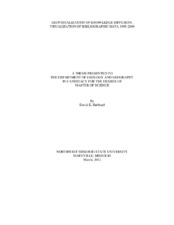| dc.description.abstract | Bibliometrics are an important research area within information and library science, which provides valuable insights about relationships between authors, publications, and knowledge domains. This study examined the geographic aspects of literature involving the visualization of bibliographic data published by authors residing in the contiguous United States. It determined where visualization of bibliometric research occurred and explored the spatial relationships among its contributors via institutional affiliation. The study involved five aspects: (1) cited publications, (2) citing publications, (3) cited-citing publication networks, (4) co-author networks and distances, and (5) hypothesis testing of average co-author distances over time.
Using 102 publications identified from Thomson Reuters’ Web of Science in the field of visualization of bibliographic data, it demonstrated that spatial aspects of bibliographic data can be represented in ArcGIS as both points (institutions) and networks (cited-citing pairs). The study examined clustering of the bibliographic data based institutional affiliation (i.e., ZIP code) using a nearest neighbor analysis. A Visual Basic for Applications (VBA) script was used to create polylines for cited-citing publication and co-author networks. The networks were mapped using small multiples and animation. Average co-author distances were calculated for the co-author networks and temporal changes were explored formally using a nonparametric hypothesis test. The average nearest neighbor analysis found that both cited and citing publications involving visualization of bibliographic data were clustered. Visual inspection of the thematic maps showed clustering of both cited and citing maps concentrated in the following cities: Philadelphia, PA, Bloomington, IN, Sandia, NM, Stillwater, OK, and Tucson, AZ. Despite a statistically significant increase in the number co-authored publications on visualization of bibliographic data, there was no change in the average co-author distances from 2001-2009. | en |



